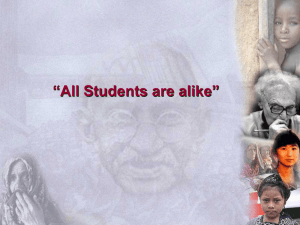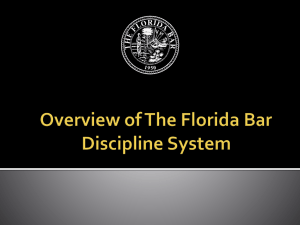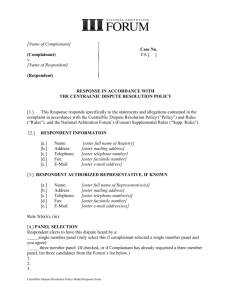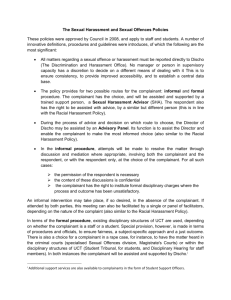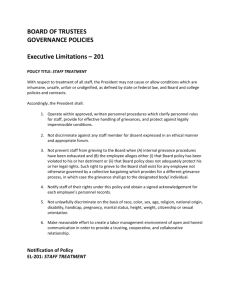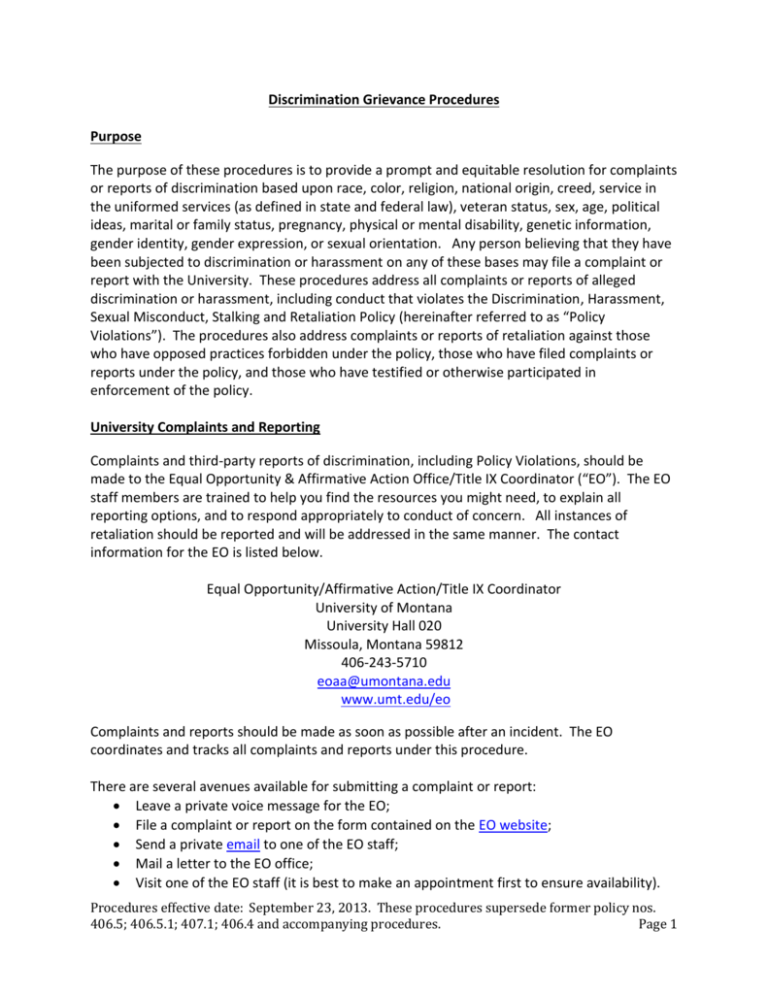
Discrimination Grievance Procedures
Purpose
The purpose of these procedures is to provide a prompt and equitable resolution for complaints
or reports of discrimination based upon race, color, religion, national origin, creed, service in
the uniformed services (as defined in state and federal law), veteran status, sex, age, political
ideas, marital or family status, pregnancy, physical or mental disability, genetic information,
gender identity, gender expression, or sexual orientation. Any person believing that they have
been subjected to discrimination or harassment on any of these bases may file a complaint or
report with the University. These procedures address all complaints or reports of alleged
discrimination or harassment, including conduct that violates the Discrimination, Harassment,
Sexual Misconduct, Stalking and Retaliation Policy (hereinafter referred to as “Policy
Violations”). The procedures also address complaints or reports of retaliation against those
who have opposed practices forbidden under the policy, those who have filed complaints or
reports under the policy, and those who have testified or otherwise participated in
enforcement of the policy.
University Complaints and Reporting
Complaints and third-party reports of discrimination, including Policy Violations, should be
made to the Equal Opportunity & Affirmative Action Office/Title IX Coordinator (“EO”). The EO
staff members are trained to help you find the resources you might need, to explain all
reporting options, and to respond appropriately to conduct of concern. All instances of
retaliation should be reported and will be addressed in the same manner. The contact
information for the EO is listed below.
Equal Opportunity/Affirmative Action/Title IX Coordinator
University of Montana
University Hall 020
Missoula, Montana 59812
406-243-5710
eoaa@umontana.edu
www.umt.edu/eoIX Coordinator
Complaints and reports should be made as soon as possible after an incident. The EO
coordinates and tracks all complaints and reports under this procedure.
There are several avenues available for submitting a complaint or report:
Leave a private voice message for the EO;
File a complaint or report on the form contained on the EO website;
Send a private email to one of the EO staff;
Mail a letter to the EO office;
Visit one of the EO staff (it is best to make an appointment first to ensure availability).
Procedures effective date: September 23, 2013. These procedures supersede former policy nos.
406.5; 406.5.1; 407.1; 406.4 and accompanying procedures.
Page 1
Report to another trusted University official (e.g., Resident Assistant, Professor, Coach,
Advisor) who will provide information as required under the policy to the EO.
If there is a complaint about the EO or any staff member that is part of the EO Office, or if the
EO or EO staff has a complaint, that complaint should be filed with the President of the
University. The President will appoint another trained individual to take the place of the EO for
purposes of the complaint.
Criminal Reporting
Please remember that if someone is in immediate danger or needs immediate medical
attention, the first place to report is 911. You may also report to the University of Montana
Police Department (406-243-4000), or to the Missoula City Police Department (406-552-6300).
Some forms of discrimination and harassment may also be crimes. For example, sexual assault,
stalking and rape are crimes. Criminal reports should be made to law enforcement, even if it is
uncertain whether the particular conduct is a crime. The EO is available to assist in making a
criminal report. Calling local law enforcement can help you: Obtain emergency and
nonemergency medical care; get immediate law enforcement response for your protection;
understand how to provide assistance in a situation that may escalate to more severe criminal
behavior; arrange a meeting with victim advocate services; find counseling and support; initiate
a criminal investigation; and answer questions about the criminal process.
Confidentiality of Complaints and Reports
Parties in these processes, including the Complainant, the individual accused of a Policy
Violation (“Respondent”), and witnesses, have privacy rights and reasonable expectations of
confidentiality in the investigation of matters subject to this procedure. In addition, the
integrity of the process depends on ensuring reasonable expectations of confidentiality. The
EO will keep confidential the complaint, report, witness statements, and any other information
provided by the Complainant, Respondent, or witnesses and will disclose this information only
to the Complainant, Respondent, or witnesses, as necessary to give fair notice of the allegations
and to conduct the investigation; to law enforcement consistent with state and federal law; to
other University officials as necessary for coordinating interim measures or for health, welfare,
and safety reasons, and to government agencies who review the University’s compliance with
federal law. The investigation report and any written decision from the Discrimination
Grievance Committee will be disclosed only to the Complainant, Respondent, EO, Discipline
Authority1 as necessary, and University officials as necessary to prepare for subsequent
proceedings (e.g., University President and University Legal Counsel). Members of the
Discrimination Grievance Committee have the same strict obligations to keep all information
they learn confidential, subject to the limited exception when necessary to protect health,
1
In the case of employees, the Discipline Authority is the University Administrator with the authority to impose
sanctions in accordance with applicable employment policies and procedures and collective bargaining
agreements. In the case of students, the Discipline Authority is the Dean of Students.
Procedures effective date: September 23, 2013. These procedures supersede former policy nos.
406.5; 406.5.1; 407.1; 406.4 and accompanying procedures.
Page 2
welfare or safety. Information about complaints and reports, absent personally identifiable
information, may be reported to University officials, including the University Council on
Student Assault, and external entities for statistical and analysis purposes pursuant to federal
and state law and University policy.
Anonymous and Third Party Reporting
The EO accepts anonymous and third-party reports of conduct alleged to violate this Policy and will
follow up on such reports. The individual making the report (Reporter) is encouraged to provide as
much detailed information as possible to allow the EO to investigate and respond as appropriate. The
EO may be limited in the ability to investigate an anonymous report unless sufficient information is
furnished to enable the EO to conduct a meaningful and fair investigation.
Role of the EO
The EO is charged with coordinating the University’s compliance with federal civil rights laws, all
of which are listed at the end of these Procedures. The EO is not an advocate for either the
Complainant or the Respondent. The EO will explain to both parties the informal and formal
processes outlined below and the confidentiality provisions as outlined above. Where
appropriate, the EO will provide to both parties information about options for obtaining
medical and counseling services; information about making a criminal report, information
about receiving advocacy services, information about other helpful campus and community
resources. The EO will offer to coordinate with other campus officials, when appropriate, to
implement interim remedial measures such as no-contact orders, rearrangement of living
arrangements, or academic accommodations. The EO will describe the process of a fair and
impartial investigation. The EO will explain the right of the Respondent to review and respond
to allegations and evidence against him or her. The EO will explain to both parties their rights
to have a person of support, union representative, or attorney, with them during their
interviews and during the hearing stage of these procedures. If an individual does not want to
pursue a complaint, the EO will inform the individual that the University is limited in the actions
it can take without the cooperation of the individual. The EO will also explain to parties and
witnesses that retaliation for reporting alleged violations of the policy, or participating in an
investigation of an alleged violation, is strictly prohibited and that any retaliation should be
immediately reported and will be promptly addressed.
Immediate Action and Interim Measures
Interim measures are those services, accommodations, or other assistance that the University
puts in place after receiving a report of sexual misconduct, harassment, stalking, or retaliation.
These measures are put in place before any final outcomes of investigatory, disciplinary or
remedial processes. Interim measures are intended to assist or protect the parties during the
grievance process, as necessary. The University determines which measures are necessary on a
case-by-case basis. Such measures may include arranging for changes in class schedules or
living arrangements, transportation accommodations, issuing a no-contact order, obtaining
Procedures effective date: September 23, 2013. These procedures supersede former policy nos.
406.5; 406.5.1; 407.1; 406.4 and accompanying procedures.
Page 3
counseling, temporarily modifying test schedules or other class requirements, assistance in
arranging for alternative University employment arrangements and/or changing work
schedules, assistance in identifying an advocate to help secure additional resources or
assistance including off-campus and community advocacy, support and services; assistance in
obtaining disability services.
Resolution
If a Complainant chooses to file a complaint, there are two avenues for resolution of an alleged
Policy Violation: formal and informal resolution. The Complainant has the option to proceed
informally, when permissible. In cases involving allegations of sexual assault, informal
resolution is not appropriate, even if both the Complainant and Respondent indicate a
preference for informal resolution.2 The EO is available to explain the informal and formal
resolution procedures.
A. Informal Process and Resolution
If the Complainant, the Respondent, and the EO all agree that an informal resolution should be
pursued, the EO (or her/his designee) shall attempt to facilitate a resolution of the conflict that
is agreeable to all parties. Under the informal process the EO shall be required only to conduct
such fact-finding as is useful to resolve the conflict and as is necessary to protect the interests
of the parties, the University and the community. Typically, an informal investigation will be
completed within twenty (20) days of receipt of the complaint. If it becomes necessary to
extend the process, both parties will be notified of a revised expected resolution timeframe.
A Complainant or Respondent always has the option to request a formal investigation. The EO
also always has the discretion to initiate a formal investigation. If at any point during the
informal process, the Complainant, the Respondent, or the EO wishes to cease the informal
process and to proceed through formal grievance procedures, the formal process outlined
below will be invoked.
The informal resolution must adequately address the concerns of the Complainant, as well as
the rights of the Respondent and the overall intent of the University to stop, remedy and
prevent Policy Violations. (Informal actions might include, but are not limited to: providing
training to a work unit; having an informal discussion with an individual whose conduct, if not
stopped, could rise to the level of discrimination, or hostile environment harassment; or having
a confidential conversation with a supervisor or instructor).
B.
Formal Process
(EO refers to the EO or trained designee.)
2
The U.S. Department of Education, Office for Civil Rights, Dear Colleague Letter, dated April 4, 2011, p. 8, states:
[I]n cases involving allegations of sexual assault, mediation is not appropriate even on a voluntary basis.
Procedures effective date: September 23, 2013. These procedures supersede former policy nos.
406.5; 406.5.1; 407.1; 406.4 and accompanying procedures.
Page 4
Step 1: EO discusses concerns with Complainant, and the Respondent as appropriate, including
providing information about the policy and procedures and other helpful resources. EO also
considers whether immediate or interim actions or involvement of other University offices is
appropriate. EO determines whether the office has jurisdiction to investigate the matter. The
EO only has jurisdiction to investigate complaints alleging discrimination, harassment, sexual
misconduct, stalking, and retaliation.
Option 1: If the EO determines that there is no jurisdiction, the EO will offer to assist
the Complainant and, as appropriate, the Respondent, in finding appropriate campus and offcampus resources for addressing the issue of concern.
Option 2: If the EO determines that there is jurisdiction, the EO will proceed to Step 2.
Step 2: EO conducts or oversees the conducting of a fair and impartial investigation of the
alleged Policy Violation and proceeds to Step 3. Typically an investigation will be completed
within twenty (20) days of receipt of the complaint. If it becomes necessary to extend the
process, both parties will be notified of a revised expected resolution timeframe.
Only a trained investigator will conduct an investigation. Respondents will have the
opportunity to review and respond to evidence considered against them. Both parties will have
the opportunity to review and provide comments to the investigator about the written
investigation report before it is finalized.
Step 3: EO determines whether there is a preponderance of the evidence to believe that an
individual engaged in a Policy Violation. This means that individuals are presumed not to have
engaged in alleged conduct unless a “preponderance of the evidence” supports a finding that
the conduct has occurred. This “preponderance of the evidence” standard requires that the
evidence supporting each finding be more convincing than the evidence in opposition to it.
In making the determination of whether harassment has created a hostile environment, the EO
will consider not only whether the conduct was unwelcome to the Complainant, but also
whether a reasonable person in the Complainant’s situation would have perceived the conduct
as objectively offensive. The EO’s findings will be in writing and will be provided to both the
Complainant and to the Respondent(s).
Option 1: If EO finds a preponderance of the evidence of a Policy Violation does not
exist, the matter is documented and closed; in this case the Complainant may appeal the
finding to the Discrimination Grievance Committee.
Option 2: If EO finds by a preponderance of the evidence that a policy violation exists,
the EO’s written report will include recommendations for steps to take to prevent recurrence of
any such violation, and as appropriate, remedies for the Complainant. The Respondent may
appeal the finding to the Discrimination Grievance Committee. In the case of student
Procedures effective date: September 23, 2013. These procedures supersede former policy nos.
406.5; 406.5.1; 407.1; 406.4 and accompanying procedures.
Page 5
Respondents, the Discipline Authority will be the Dean of Students. In the case of employees,
the Discipline Authority is the University Administrator with the authority to impose sanctions
in accordance with applicable employment policies and procedures and collective bargaining
agreements. The Discipline Authority must inform the EO of the ultimate sanctions imposed
upon a Respondent. The EO will inform the Complainant of the sanctions as permitted by
applicable Title IX and privacy laws.
Relation to the Student Code of Conduct
The Dean of Students is charged with imposing sanctions on students who are found to have
violated the policy. Sanctions may include eviction from campus housing, suspension,
expulsion, probation, a warning, or any other sanction set forth in the Student Conduct Code at
Section VI.C. Disciplinary records for policy violations are maintained in the same manner as
other disciplinary records, as described at Section VI.F. of the Student Conduct Code.
Reporter or Complainant Requests No Investigation
If a reporter or Complainant requests that an investigation not be conducted, the EO will
consider the reasons for the request, including concerns about continued safety of the person
reportedly harmed and members of the campus community. The EO must also balance
considerations about the continued health and safety of members of the community against a
reporter’s or Complainant’s desire not to have the report investigated. In cases when a
reporter or Complainant does not want to have a report investigated, but the EO has concerns
that not taking formal or informal action might endanger the health or safety of members of
the campus community, the EO may initiate confidential consultation with appropriate
individuals to analyze the situation and assist in determining appropriate measures to take.
Consultation may occur with the Dean of Students, chair(s) of the Behavioral Intervention Team
(BIT), Public Safety Officer, Clery Compliance Officer, Director of Student Advocacy Resource
Center, psychological health professional, Director of Residence Life, Director of Human
Resources, and legal counsel. The EO will make the ultimate decision about whether to
conduct a formal investigation or respond to the report in another manner, including taking
informal actions, such as those described above. Whether or not an investigation is conducted,
the University will provide, as necessary, interim measures.
Appeals to the Discrimination Grievance Committee
Composition of the Committee
The committee shall have four (4) regular members including the Chair. Of the four regular
members, one shall be a student, one shall be a member of the faculty, one shall be a member
of the non-academic staff, and one shall be representatives of the administration.
Selection of Members
Procedures effective date: September 23, 2013. These procedures supersede former policy nos.
406.5; 406.5.1; 407.1; 406.4 and accompanying procedures.
Page 6
Members shall be appointed by the President of the University. Each of the four groups listed
below will nominate four (4) candidates. The President will appoint one member from each
pool of four (4) candidates. The President shall also designate one (1) alternate from each of
these groups:
1.
The Executive Committee of the Faculty Senate.
2.
The Executive Committee of the Staff Senate.
3.
The President’s Staff.
4.
The President of ASUM with the approval of Student Senate.
Appointment of Chair
The President shall appoint the Chair.
Term of Appointment
To assure cumulative experience and development of expertise as well as continuity and
uniformity of decisions, the terms of regular members will be of extended duration. The
student shall be appointed for two (2) years. Members of each of the other groups (faculty,
non-academic staff, and administrators) shall be appointed for five (5) years.
Any member whose term has expired and who is willing to continue to serve on the committee
may be reappointed by the President of the University.
The President may appoint one or more persons to serve temporarily as a member of the
committee to fill a vacancy or ensure a quorum, or in response to a request from the Chair to
avoid delay in proceedings. The term of temporary appointment continues for the duration of
the proceedings or until the temporary appointee is replaced by a regular member.
Removal of Members
The Committee Chair may either permanently or temporarily remove or replace any regular
member of the committee under the following circumstances:
a. In response to a request from those responsible for the nomination of the
member;
b. In response to a request from a majority of the committee members;
c. In response to a request from the Equal Opportunity Officer;
d. In response to a request from a committee member that he/she be excused;
e. In response to a request from a party who raises a legitimate concern
regarding a conflict of interest.
If any person or group other than the member requests removal, that member will have an
opportunity to rebut any evidence presented in support of the request for removal. If a
concern as enumerated above is raised about the Chair, the President of the University will
make the determination about either permanently or temporarily removal from the committee.
Procedures effective date: September 23, 2013. These procedures supersede former policy nos.
406.5; 406.5.1; 407.1; 406.4 and accompanying procedures.
Page 7
Quorum
There must be a member from each of the four constituent groups specified above to
constitute a quorum.
Authority of the Committee
The committee may: (1) call student and employee witnesses to testify or to be present during
a hearing, and obtain other evidence held by the University or any student or University
employee; (2) arrange with the University EO for appropriate funding and staff support to
facilitate hearings; (3) hold pre-hearing conferences; (4) issue hearing orders; (5) hold formal
hearings and control conduct of such hearings; and (6) make decisions, findings of fact, and
recommendations, including recommended sanctions, to the President by vote of a majority of
the regular members involved in the hearing process.
Filing an Appeal
A request for a hearing before the University Discrimination Grievance Committee must be filed
within five (5) working days, of the receipt of the EO’s decision, unless good cause can be
shown for an extension of time. The request for a hearing must be filed with the EO. The
request for a hearing must be in writing and must describe the appellant’s desired outcome; as
well as describe how the appellant believes the EO: (1) exhibited unfair bias which influenced
the result of the investigation; (2) failed to conduct a thorough investigation; (3) issued
arbitrary findings and recommendations; (4) had a conflict of interest; or (5) issued findings and
recommendations that if adopted would result in substantial injustice. As soon as practicable,
the EO will provide the non-appealing party and the Chair of the Discrimination Grievance
Committee with a copy of the written appeal.
Standard of Review
The committee reviews the findings and recommendations of the EO. The committee may
approve, overturn, or modify the findings and recommendations of the EO. The committee
may overturn or modify the EO’s findings and recommendations if it finds that the EO: (1)
exhibited unfair bias which influenced the result of the investigation; (2) failed to conduct a
thorough investigation; (3) issued arbitrary findings and recommendations; (4) had a conflict of
interest; or (5) issued findings and recommendations that if adopted would result in substantial
injustice.
Notice of Hearing
Within ten (10) working days of receipt of the written request for a hearing, the EO will notify
the Complainant and the Respondent of the time and place of the formal hearing before the
Discrimination Grievance Committee. This process might be extended during periods between
Procedures effective date: September 23, 2013. These procedures supersede former policy nos.
406.5; 406.5.1; 407.1; 406.4 and accompanying procedures.
Page 8
academic semesters when a quorum of the committee cannot be convened. The hearing will
normally be scheduled within thirty (30) days of receipt of the written appeal. If such an appeal
causes a significant delay, the EO will consider interim measures, as described above, to
continue to protect the parties during the process.
Preparation for and Conduct of the Hearing
Written Statements on Appeal
Within ten (10) working days of filing the appeal, the party appealing the decision must submit
to the EO the following information:
(a) detailed statement of facts relevant to the complaint or report of discrimination, hostile
environment harassment, sexual misconduct, stalking, or retaliation; (b) names and addresses
and anticipated testimony from witnesses to be called; (c) copies of any documents which will
be submitted as evidence; (d) additional materials the party believes the committee should
obtain prior to the hearing; (e) reference to the portion of the policy alleged to be violated; (f)
specific remedy(ies) requested; and (g) whether the party will be represented by legal counsel
and the identity of the counsel.
The non-appealing party may also submit the information described in (a) through (f), above. If
the non-appealing party will participate in the hearing, that party must notify the EO as
described above at (g) whether he or she will be represented by legal counsel. In cases in which
the non-appealing party chooses not to participate in the hearing, the EO will provide to the
Discrimination Grievance Committee, in addition to the written investigation report, any
additional documents or other materials, and names and addresses of any witnesses the EO
believes should provide information to the Committee at the hearing.
Legal Counsel Representation
Both parties have a right to be represented by legal counsel. If either party chooses to be
represented by legal counsel, University Legal Counsel will be present to ensure that the rights
of all interested persons and the University are respected. The role of a party’s attorney shall
be limited to consultation with the attorney’s client and client witnesses.
Forwarding Appeal Documents
The EO will forward copies of the EO’s written investigation report; the above-listed materials;
and any additional evidence relevant to the matter to the members of the Discrimination
Grievance Committee at least five (5) days prior to the hearing.
Pre-hearing Conference
At any time within five (5) days prior to the date of the formal hearing the Chairperson of the
University Discrimination Grievance Committee may call a pre-hearing conference. Topics
discussed at a pre-hearing conference may include, but are not limited to: (a) whether the
evidence presented is complete; (b) whether additional investigation is required; (c) whether
Procedures effective date: September 23, 2013. These procedures supersede former policy nos.
406.5; 406.5.1; 407.1; 406.4 and accompanying procedures.
Page 9
additional witness should be called; and (d) time limits and order of presentation of evidence at
the hearing. At the request of any party, the Committee Chairperson will conduct separate
meetings with the appellant and the respondent for purposes of the pre-hearing conference.
With concurrence of a majority of the University Discrimination Grievance Committee, the
Chair may decide to: set aside the hearing date for any period up to ten (10) days for additional
investigation, to obtain additional witnesses or evidence.
The Hearing
The Chair of the Discrimination Grievance Committee, when mutually agreed upon by the
parties, may serve as or appoint another trained Hearing Officer to hear the appeal without the
Committee. In all other cases the Chair of the University Discrimination Grievance Committee
will conduct the hearing with the Committee. The hearing will be a non-adversarial proceeding
and strict rules of evidence will not be applied. However, the Chair of the Committee may limit
or refuse to allow evidence or testimony that is not reasonably related to a determination of
whether a violation of the policy occurred.
The hearing will be conducted to assure fairness and accuracy in fact-finding. The parties and
witnesses will address the members of the Committee rather than each other. The Chair will be
the final arbiter of all matters of procedure. All hearings are closed to the public.
The Decision
Within ten (10) working days of the conclusion of the formal hearing the University
Discrimination Grievance Committee will submit a decision in writing to the parties, the EO and
to the President. The written decision will contain the following:
a.
A summary of the allegations including a description of the harm
alleged to have been caused;
b.
A summary of the response to the allegations;
c.
A statement of the relief sought by the Complainant if known, or of
the recommendation of the EO, if applicable;
d.
Specific reference to the portion(s) of the policy(ies) alleged to have
been violated;
e.
Analysis of whether the EO: (1) exhibited unfair bias which
influenced the result of the investigation; (2) failed to conduct a
thorough investigation; (3) issued arbitrary findings and
recommendations; (4) had a conflict of interest; or (5) issued
findings and recommendations that if adopted would result in
substantial injustice; and
Procedures effective date: September 23, 2013. These procedures supersede former policy nos.
406.5; 406.5.1; 407.1; 406.4 and accompanying procedures.
Page 10
f.
Recommendations, if any, regarding redress of the complaint as well
as any other recommendations, as applicable, for precluding further
policy violations.
Action on Decision
The President will review the Committee’s decision. The President’s review is limited to
determining: (1) Whether the evidence provides a reasonable basis for the resulting decision;
and (2) Whether specified procedural errors were so substantial as to deny a fair hearing to
either party. Within ten (10) days of receipt of the Committee's decision, the President will
notify the Committee Chair, the Equal Opportunity Officer, and the parties, in writing, of the
decision relative to each of the findings and recommendations forwarded by the University
Discrimination Grievance Committee. The Equal Opportunity Officer will distribute copies to
Committee members and to the parties.
Appeal to Regents
Within twenty (20) days of receipt of the President's decision either party may appeal the
President's decision to the Commissioner of Higher Education of the Montana University
System. (See Board policy on appeals No. 203.5.2). If such an appeal causes a significant delay,
the EO will consider interim measures, as described above, to continue to protect the parties
during the process.
Conflict of Interest and Training
All University officials who are involved in the discrimination grievance process, including the
EO, designated investigators, Discrimination Grievance Committee, and Discipline Authorities,
will have adequate training. Training will address, but is not limited to, recognizing and
appropriately responding to allegations of discrimination, harassment, including hostile
environment harassment, sexual misconduct, and retaliation, conducting investigations,
protecting confidentiality, and recognizing the link between alcohol and drug use and sexual
assault and sexual harassment.
The names of the investigator and the individuals who will serve on the Discrimination
Grievance Committee for a particular matter will be readily accessible. These individuals must
promptly disclose any potential conflict of interest they might have in a particular case. In the
rare situation in which an actual or perceived conflict of interest arises between an Investigator,
or member of the Discrimination Grievance Committee, that conflict must be disclosed to both
parties.
External Complaints
If you filed a complaint with the EO and believe the University’s response was inadequate, or
you otherwise believe you have been discriminated against by the University on the basis of
race, color, national origin, sex, including sexual harassment, disability age, or retaliation, you
Procedures effective date: September 23, 2013. These procedures supersede former policy nos.
406.5; 406.5.1; 407.1; 406.4 and accompanying procedures.
Page 11
may file a complaint with the Office for Civil Rights (OCR) of the U.S. Department of Education
based in Seattle or the Educational Opportunities Section (EOS) of the Civil Rights Division of
the U.S. Justice Department of Justice, and a complaint based on religion with EOS of the U.S.
Justice Department.
As a student or employee, if you filed a complaint with the EO and believe the University’s
response was inadequate, or you otherwise believe you have been discriminated against by the
University on the basis of race, color, national origin, sex, including sexual harassment,
disability, age, religion, creed, pregnancy, marital status, familial status (housing only), or
political beliefs, or retaliation, you may file a complaint with the Montana Human Rights
Bureau: http://erd.dli.mt.gov/human-rights-bureau.html, 406-444-4356.
References: Titles IV, VI, and VII of the Civil Rights Act of 1964; 34 C.F.R. pt. 100; Title IX of the
Education Amendments of 1972; 28 C.F.R. pt. 54 and 34 C.F.R. pt. 106; Section 504 of the
Rehabilitation Act; 34 C.F.R. pt. 104; Age Discrimination Act of 1975; 34 C.F.R. pt. 110; and Titles
I and II of the Americans with Disabilities Act; 28 C.F.R. pt. 35; Montana Human Rights Act and
Governmental Code of Fair Practices, Title 49, Montana Code Annotated; Board of Regents
Policy 507.
Procedures effective date: September 23, 2013. These procedures supersede former policy nos.
406.5; 406.5.1; 407.1; 406.4 and accompanying procedures.
Page 12

